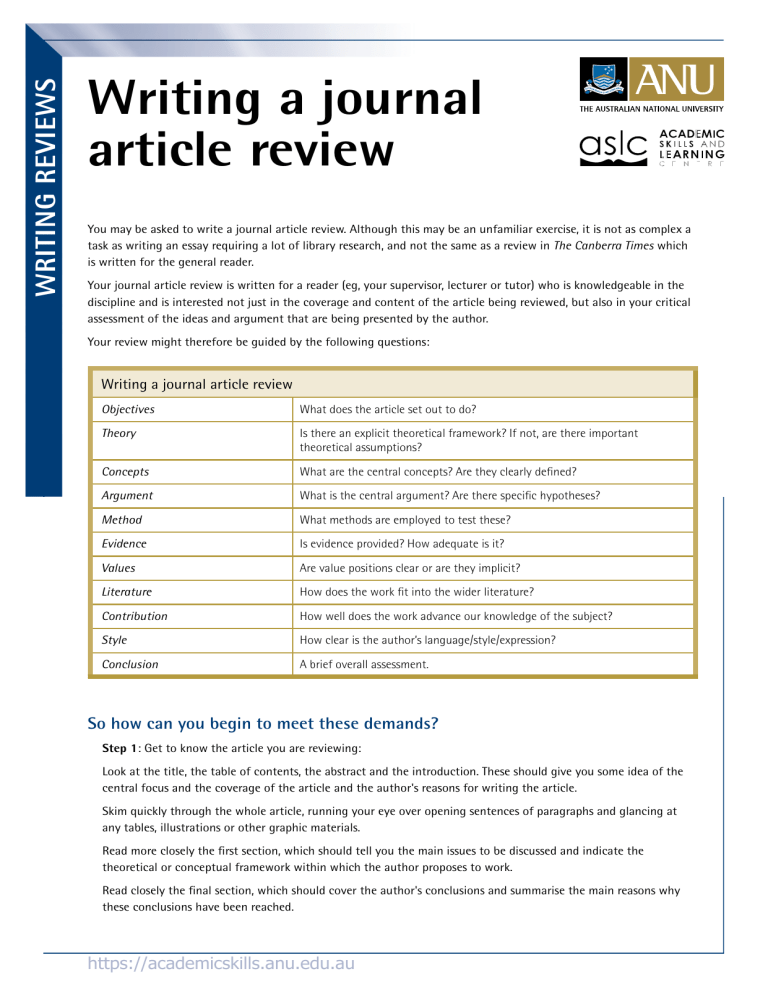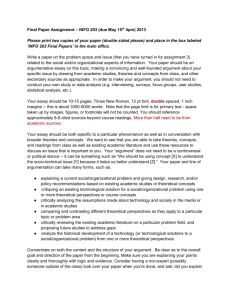
writing reviews Writing a journal article review You may be asked to write a journal article review. Although this may be an unfamiliar exercise, it is not as complex a task as writing an essay requiring a lot of library research, and not the same as a review in The Canberra Times which is written for the general reader. Your journal article review is written for a reader (eg, your supervisor, lecturer or tutor) who is knowledgeable in the discipline and is interested not just in the coverage and content of the article being reviewed, but also in your critical assessment of the ideas and argument that are being presented by the author. Your review might therefore be guided by the following questions: Writing a journal article review Objectives What does the article set out to do? Theory Is there an explicit theoretical framework? If not, are there important theoretical assumptions? Concepts What are the central concepts? Are they clearly defined? Argument What is the central argument? Are there specific hypotheses? Method What methods are employed to test these? Evidence Is evidence provided? How adequate is it? Values Are value positions clear or are they implicit? Literature How does the work fit into the wider literature? Contribution How well does the work advance our knowledge of the subject? Style How clear is the author’s language/style/expression? Conclusion A brief overall assessment. So how can you begin to meet these demands? Step 1: Get to know the article you are reviewing: Look at the title, the table of contents, the abstract and the introduction. These should give you some idea of the central focus and the coverage of the article and the author's reasons for writing the article. Skim quickly through the whole article, running your eye over opening sentences of paragraphs and glancing at any tables, illustrations or other graphic materials. Read more closely the first section, which should tell you the main issues to be discussed and indicate the theoretical or conceptual framework within which the author proposes to work. Read closely the final section, which should cover the author's conclusions and summarise the main reasons why these conclusions have been reached. https://academicskills.anu.edu.au Now that you are familiar with the text, read the whole text thoroughly to develop a basis on which to critically review it. Step 2: Decide which aspects of the article you wish to discuss in detail in your review: the theoretical approach? the content or case studies? the selection and interpretation of evidence? the range of coverage? the style of presentation? Usually you will discuss the main issues which the author has specifically examined. Sometimes you may choose a particular issue because it has importance for you and the course you are studying, even if it is not the main issue for the author. Step 3: Now, on the basis of your overall knowledge of the article and your decision about which issues you will discuss, read in closer detail the sections which are relevant to these issues. Make notes of the main points and key quotations. If necessary, read other articles or books which are relevant to your topic, possibly to provide supporting evidence or alternative theoretical models or interpretations of data. You may also want to glance at other reviews of the article in recent academic journals in order to get a feel for the way the article has been received within the discipline. However only use these reviews to support your own evaluation; don't merely copy or imitate them. Now you are ready to start drafting and writing your review. The structure of your review should include: • an initial identification of the article (author, title of article, title of journal, year of publication, and other details that seem important, eg, it is originally a French edition, etc), and an indication of the major aspects of the article you will be discussing. • a brief summary of the range, contents and argument of the article. Occasionally you may summarise section by section, but in a short review (1,000-1,500 words) you usually pick up the main themes only. This section should not normally take up more than a third of the total review. • a critical discussion of 2-3 key issues raised in the article. This section is the core of your review. You need to make clear the author's own argument before you criticise and evaluate it. Also you must support your criticisms with evidence from the text or from other writings. You may also want to indicate gaps in the author's treatment of a topic; but it is seldom useful to criticise a writer for not doing something they never intended to do. • a final evaluation of the overall contribution that the article has made to your understanding of the topic (and maybe its importance to the development of knowledge in this particular area or discipline, setting it in the context of other writings in the field). Checklist for your final draft: • Have you identified the article clearly, right at the start? • Is the author's argument clearly and objectively summarised so that your reader can recognise the theoretical approach and the range of material covered? (About a third of a short review.) • Are the 2-3 key issues raised in this article clearly identified and discussed? (About 50-60% of the review.) • Have you given reasons for your criticism and your approval of the article? • Is there a final evaluation of the article's importance, based on your earlier discussion? ANU CRICOS Provider Number 00120C © 2009 Academic Skills and Learning Centre (ASLC), The Australian National University. This handout may be used and changed for educational purposes, so long as ASLC is appropriately acknowledged. https://academicskills.anu.edu.au



